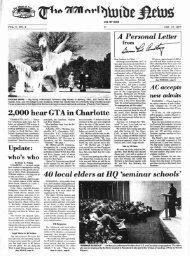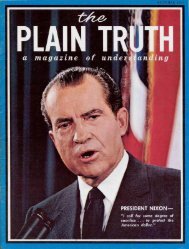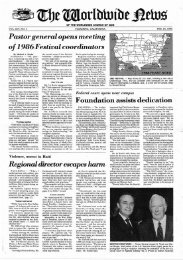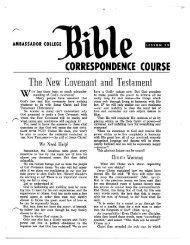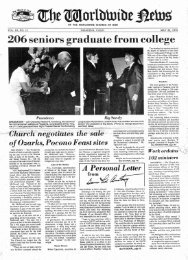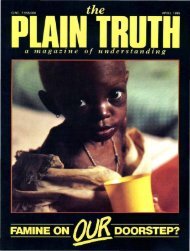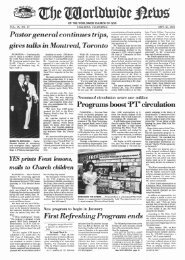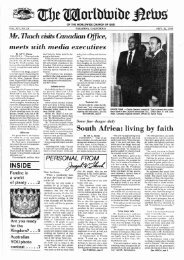Plain Truth 1978 (Prelim No 04) Apr - Herbert W. Armstrong
Plain Truth 1978 (Prelim No 04) Apr - Herbert W. Armstrong
Plain Truth 1978 (Prelim No 04) Apr - Herbert W. Armstrong
Create successful ePaper yourself
Turn your PDF publications into a flip-book with our unique Google optimized e-Paper software.
W<br />
e've come a long way<br />
since the early days of the<br />
Republic , when the federal<br />
budget amounted to a few " paltry"<br />
tens of millions of dollars. Ittook a full<br />
173 years-from the founding of the<br />
United States in 1789 until 1962-for<br />
America 's national budget to hit the<br />
staggering $100 billion mark. It took<br />
only nine more years, until 1971 , to<br />
reach $200 billion. Four years later<br />
we surpassed $300 billion, and two<br />
years after that, $400 billion . <strong>No</strong>w,<br />
President Carter has proposed a<br />
$500 billion budget for fiscal 1979 ,<br />
which begins October 1, <strong>1978</strong>-an<br />
increase of $38 billion from the previous<br />
year.<br />
It's hard for the average person<br />
to grasp just how much a half-trillion<br />
is. Here's one way: If you put<br />
that amount in a line of dollar bills<br />
laid end to end, it would reach to<br />
the moon and back 250 times!<br />
Stacked up, 500 billion silver dollars<br />
would reach as high as<br />
2,830 ,500 Empire State Buildings .<br />
Looking at it another way: If you<br />
had started at the birth of Christ to<br />
spend $700,000 a day, 365 days a<br />
year, you would just now, in <strong>1978</strong>,<br />
finally be getting rid of $500 billion.<br />
<strong>No</strong>w we are going to be spending<br />
that much in a single year! And by<br />
fiscal year 1986-just eight years<br />
away-we will probably be spending<br />
double that amount: a full trillion<br />
dollars! The prospect is mindboggling!<br />
38<br />
On the Road to Ruin?<br />
Moreover, the government expects<br />
to take in by taxation only<br />
$440 billion (if one can use " only"<br />
to describe such a sum), assuming<br />
President Carter's proposed $25<br />
billion tax cut to stimulate the economy<br />
is enacted this fall. This would<br />
leave a budget deficit of slightly<br />
over $60 billion to be covered by increased<br />
g ove r n me nt bo rrowing-and<br />
that on top of a roughly<br />
equal red-ink total for fiscal <strong>1978</strong>.<br />
We will thus be racking up the biggest<br />
two-year deficit in the history<br />
of the nation .<br />
This gives us yet another way of<br />
putting the new budget into perspective<br />
. In the coming fiscal year,<br />
the federal deficit alone-$60 billion-will<br />
be nearly 12 times greater<br />
than the entire federal budget during<br />
<strong>Herbert</strong> Hoover's last year as<br />
president! In that year, the federal<br />
budget totaled less than $5 billion ,<br />
a mere one-hundredth of today 's<br />
figure.<br />
Continued defic it spending has<br />
resulted in a steadily growing national<br />
debt now standing at some<br />
three-quarters of a trillion<br />
dollars-almost $3300 for every<br />
man, woman, and child in the<br />
nation. Moreover, the interest<br />
which must be paid on this debtjust<br />
as private individuals have to<br />
pay interest on loans from banksamounts<br />
to over $50 billion annually.<br />
Thus, the interest burden on<br />
our national debt will constitute a<br />
full ten percent of the 1979 fiscal<br />
budqetl<br />
What are the reasons for the<br />
soaring growth in government<br />
spending? Why is it that Washington-like<br />
many individual Americans-just<br />
can 't seem to hold down<br />
expenditures and bring its spending<br />
into line with its income?<br />
Inflation, of course , is partly responsible<br />
for the record leaps in<br />
federal outlays in recent years. But<br />
then again, inflation is largely<br />
caused by the borrowing and<br />
money supply incr eases necessitated<br />
by govern ment overspending.<br />
It's a vicious circle from<br />
which Washington just can 't seem<br />
to break loose. It is part of the famous<br />
"inflationary spiral. "<br />
But inflation is by no means the<br />
only culprit, as we can see by measuring<br />
federal spending as a percentage<br />
of the gross na tional<br />
product (GNP), the dollar value of<br />
the country's total output of goods<br />
and services. Going back again to<br />
the presidency of <strong>Herbert</strong> Hoover,<br />
the federal government was taking<br />
only 2.5 percent of the GNP when<br />
he assumed office in 1929. Today,<br />
Washington 's share of the GNP is a<br />
walloping 22 percent!<br />
Aside from inflation, the single<br />
most significant factor in the soaring<br />
government budqet is the<br />
alarming jump in recent years in<br />
outlays for social services-health,<br />
educatio n, welfare, and various<br />
The PLAIN TRUTH <strong>Apr</strong>il <strong>1978</strong>







